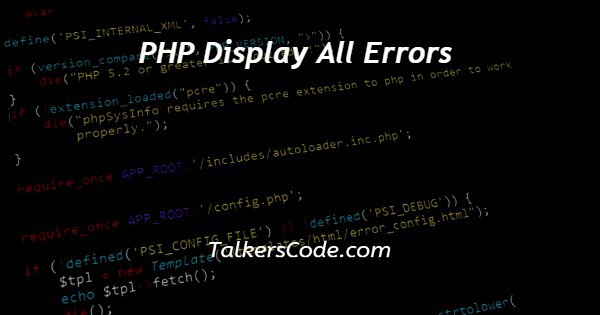In this article we will show you the solution of PHP display all errors, PHP requires the ability to identify and troubleshoot possible code problems. It's possible that PHP doesn't show all errors by default, which can make it challenging to find and address problems.
Fortunately, it is possible to set up PHP to show any issues that may arise while a script is being executed, including warnings and notices.
A few lines of code can be added to the PHP script itself or particular settings in the PHP configuration file can be changed to achieve this.
Developers can benefit from having all mistakes displayed because it can be used to spot possible issues and raise the code's overall quality. Now move to the concept of php display all errors.
Step By Step Guide On PHP Display All Errors :-
<?php
// Display all errors
ini_set('display_errors', 1);
ini_set('display_startup_errors', 1);
error_reporting(E_ALL);
?>
- You can see that in this example, we wrote PHP code that displays all errors.
- We utilize the ini_set() function at the beginning of the code to set the settings for the display_errors and display_startup_errors configuration parameters.
- The display_errors option then determines whether or not errors are displayed on the screen.
- In addition, by changing it to 1, we are instructing PHP to show errors on the screen.
- The display_startup_errors option determines whether errors that happen during PHP's startup process or when PHP is initially loaded should be shown. Then, by setting it to 1, we are instructing PHP to also display startup problems.
- The reporting of any relevant errors can be done by using the error_reporting() function.
- All errors and warnings are represented by the constant E_ALL.
- We instruct PHP to report any errors and warnings that arise while the script is being executed by setting the error reporting level to E_ALL.
- It's important to note that the error_reporting() method only influences how many mistakes are reported; it has no bearing on whether errors are displayed.
- Next, we need to use the ini_set() function, as previously described, in order to display errors.
Conclusion :-
As a result, we have successfully learnt the concept of PHP display all mistakes. We also discovered how crucial error reporting is to PHP development.
For high-quality code to be written that performs as intended, the ability to spot and correct problems is essential.
Since PHP might not show all errors by default, finding and fixing problems might be challenging.
However, by utilising the error_reporting() and ini_set() functions, we may enable error reporting.
I hope this article on PHP display all errors helps you and the steps and method mentioned above are easy to follow and implement.














